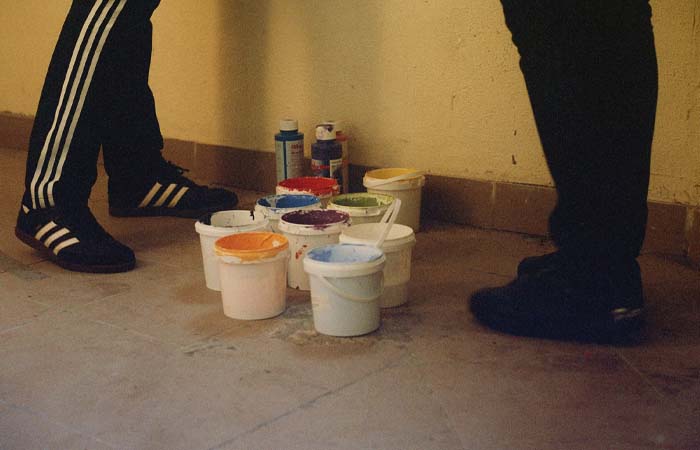Freshening up our homes with newly painted rooms is satisfying and gratifying if we have decorated ourselves.
Our rooms look new, and more importantly, we have painted our personality and maybe aspirations as we proceeded.
The problem comes when we realise the odours from the paint are bad for you. These odours are the solvents gassing off as the paint dries.
On average, in a well ventilated and warm bedroom, you will need to wait a minimum of 72 hours before it is safe to sleep in a bedroom after it has been painted. If the odour of the solvents in the paint is still present after 72 hours, please allow additional time for the solvents in the paint to evaporate and disperse.
No big deal? Think again. Solvents in paints are toxic. They are referred to in the industry and chemists as VOC’s. For you and me, that means volatile organic compounds.
Are Volatile Organic Compounds Dangerous?
We can guess part of the answer to that question is in the descriptions of the compounds. They are Volatile, meaning they are subject to change without warning.
Just because these volatiles is organic, don’t be lulled into a false sense of security. Volatile substances are found organically, and when the compounds are mixed, then we have a problem.
Is Sleeping In a Freshly Painted Room Dangerous?
Yes, it is. There are some exceptions that we can touch on later.
Sleeping in a room that has just been painted and has strong odours is potentially life-threatening, particularly to young children, the elderly and pregnant women.
If you are in good health, do not assume you can run the gauntlet and ignore the recommendations for sleeping in a freshly painted room.
Volatile Organic Compounds will, at the very best, make you feel nauseous and may even affect your breathing.
VOC’s can affect the central nervous system that controls every primary function in your body, and the results can be catastrophic.
You may experience symptoms of dizziness, memory loss and worse if exposed to the VOCs from paint for an extended time, such as eight hours of sleep.
VOCs Complications
The problem with VOCs is you can’t see them, and to some of us, the smell is not offensive. However, once the VOCs are inhaled and enter the bloodstream, serious problems can occur.
VOCs will impair your respiratory system making your lungs less able to absorb oxygen. The VOCs cab travels to the organs that deal with toxins lowering their function.
Organ Failure
VOCs can cause organ failure in young children and those susceptible and particularly vulnerable to exposure to VOCs.
Organ failure is a real possibility with prolonged exposure, so great care needs to be taken at all times.
It’s not just humans; your pets can have all the same problems and are more likely to be susceptible to serious outcomes such as death because of their size.
My Room Has Just Been Painted, How Long Before I Can Sleep In The Room?
Let’s talk about minimums. It is highly recommended that you do not sleep in a freshly painted room for at least a minimum of 72 hours.
You think that’s excessive. Think again.
If there is an odour in your bedroom while the paint is curing, then the paint is still omitting VOCs. The paint is given from toxic gas from the solvents that could cause severe problems to your health?
Allergic Reactions
Allergic reactions are possible in people who are sensitive to certain substances.n Am allergic reaction to VOCs could be realised as an asthma attack requiring immediate medication to reduce the constriction causing the difficulty breathing.
Itching and red sore eyes are symptoms of an allergic reaction, among other reactions you may experience.
If any of these symptoms occurred, you would remove yourself from the area and seek medical attention.
Can I speed up the process?
The best thing to do is to keep the room well ventilated at all times. This may include keeping doors and windows open. If you can have the room at the correct temperature as recommended by the manufacturer, it may speed the process.
Leaving windows open is sometimes tricky, especially when gloss paint is on a window sill. The last thing you need or want is dust and grime particles contaminating the freshly painted surface.
However, speeding the process is unlikely. You need to wait for the paint to cure and the odours to diminish completely.
Alternative Paints Not Containing VOCs
There are paints on the market that label themselves as eco-friendly products. Some of these paints claim not to use VOC based solvents and be entirely safe for use around the house.
For VOC free paints, read the labels of the chemicals closely and double-check. It’s almost impossible for some paints to remove the VOC solvents, and you will have a residual odour that will need to disperse before using the room.
You may need to seek the advice of a professional tradesman when choosing eco-friendly paint.
VOC solvents have been used for decades for a good reason, they dissolve the solids in paint and make the pain easier to use and flow.
Removing the solvents creates many problems when applying paints to walls and wood.
Some concepts of painting with VOC less paint is a new way of applying paint as the paints do not dry as fast.
However, some excellent alternatives with satin and silk finishes could provide you with the finish you are looking for in your freshly painted bedroom.
Final Thoughts
We have established that paints using solvents containing VOCs are potentially extremely dangerous, particularly to young children and pregnant mums.
None of us should take the risk of sleeping in a freshly painted room where VOCs are present in the form of odour.
There is no compromise on this issue, and the dangers are documented for everyone to see.
Industrial paint solvents are dangerous, and it is impossible to mitigate the risks.
Keep freshly painted rooms well ventilated and off bounds to children and pets.
The use of fans to help ventilate the rooms will help, and keeping the room warm will help the painted surfaces to dry faster and off-gas the VOCs.

 Nectar Mattress
Nectar Mattress 


